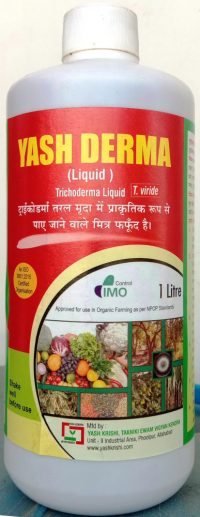Trichoderma Application for control of red rot in sugarcane
Strains of Trichoderma viride were found effective in the management of red rot in sugarcane caused by Colletotrichum falcatum Went under field condition. The antagonistic activity of Trichoderma was tested and evaluated in a highly susceptible variety.
Cane crop was grown with sett and soil treatments by T. viride and found to be highly effective. Red rot was completely controlled in 47–48% of canes. In the remaining 52–53% cases the disease symptom severity was reduced to 4–6 grade on 0–9 scale.
The biocontrol of red rot offered by T. viride up to 5-6 months was due to direct parasitic action of Trichoderma and also due to induced systemic resistance in sugarcane by the enzymatic actions of the metabolites released by the bioagent.
In addition to red rot control, T. viride also improved the germination, number of tillers, number of millable canes, and yield. An increase in plant cane productivity of 4.4 and 10.0 t / ha by sett and soil treatment was recorded with T. viride which was able to enhance the yield by 3.6 and 9.0 t / ha through sett and soil application.
Healthy setts were treated by applying Trichoderma viride strains grown in sterilized sorghum grains and subsequently mixed with sterilized press mud or FYM (50 kg) / ha.
Infection of C. falcatum was protected in 45–55% of plants. There was no infection in such plants as against 97–100% infection in check. Red rot infection was also considerably suppressed in 20–25% of plants. Where grade of infection was reduced to 2–4 in a 0–9 scale.
Trichoderma spp. formulations were applied in the field as soil and sett treatment at the time of planting. Trichoderma spp. culture multiplied in Farm Yard Manure (FYM) was applied to the soil in furrows @ 50 kg/ha. Sets were treated by dipping in spore suspension (conidia 10 6 /ml) of Trichoderma spp. for 30 min. One hundred and fifty 3-bud sets were planted in each plot and the crop was raised as per the normal package of practices.
ट्राइकोडर्मा (तरल)
ट्राइकोडर्मा तरल मृदा में प्राकृतिक रूप से पाये जाने वाले मित्र फफूँद है ।
निम्न फसलों के लिए :
तिल चाय, कॉफी इलायची, अदरख, केला, पान प्याज, नींबू, कपास, मूँगफली, सूरजमुखी, तम्बाकू, सोयाबीन, आलू, उर्द, मूँग, धान, अरहर, चना, गेहूँ, गन्ना, टमाटर, मिर्चा, फूलगोभी, बैगन, अमरूद, पपीता आदि
निम्न रोगों हेतु :
मृदा जनित रोग जैसे उक्ठा, सूखा, जड़गलन, तनागलन, अंगमारी, आर्द्रपतन, मूल ग्रंथि रोग आदि
प्रयोग के निर्देश –
बीज उपचार :
ट्राईकॆडर्मा तरल मॆं बीज को 15 मिनट डुबाएँ उसकॆ उपरांत निकाल कर छायादार स्थान पर सुखायॆं उसकॆ बाद बुआई करॆं ।
मृदा उपचार :
खेत में प्रयोग से पहले 3’ X 6’ का बेड तैयार करें उसके ऊपर 50 किलोग्रा0 सड़ी गोबर की खाद फैलाकर उसमें एक लीटर ट्राईकोडर्मा तरल अच्छी तरह मिलाएं । साथ ही ऊपर से कुछ पानी का छिड़काव कर टाट की बोरी से अच्छी तरह ढक दें । हर तीन – चार दिन पर खाद की पलटाई करें ।
15 दिनों के बाद तैयार खाद के मिश्रण को एक एकड़ खेत में डालें ।
बागों के लिए :
तैयार खाद के मिश्रण का 1 – 5 किग्रा0 प्रति पौध के दर से वर्ष में दो बार मानसून की शुरूआत एवं समाप्ति पर प्रयोग करें ।
पौध शाला उपचार :
नर्सरी हेतु 1 ली0 ट्राइकोडर्मा तरल को 100 ली0 पानी में घोल बनाकर बीज के बुआई के बाद 10 वर्ग मी0 क्षे0 के नर्सरी में छिड़काव करें ।
कंद उपचार / सेट उपचार :
कंद उपचार के लिए ट्राइकोडर्मा तरल के घोल ( 1 ली0 / 10 ली0 पानी ) में कंद डुबाकर बुआई के पूर्व छायादार स्थान पर सुखाएं ।
पौध का जड़ उपचार :
पौध रोपण के पूर्व बेहन के जड़ को (1 ली0 ट्राइकोडर्मा तरल 10 ली0 पानी ) के घोल में 15 मिनट तक उपचारित करें ।

